► Jaguar i-Pace meets Jaguar XK120
► Electric SUV vs sports car pioneer
► Gavin Green referees two Jag greats
In the white corner, long-nosed, low and lithe, is the Jaguar XK120. It’s a happy product of its post-war times, previewing the optimistic and opportunistic ’50s. It was sold on its speed, its driving zest, its passport to freedom, its wind-in-the-hair carefreeness. It reflected an age when people looked forward with confidence, not backwards with nostalgia. You dreamed of a bright future, not a better past.
It was the fastest sports car in the world, a noted and celebrated engineering achievement (nowadays such promotion would be banned by the ASA). What’s more, the bright young men and women who owned them (Hollywood heartthrob Clark Gable was the first customer) could exercise their chargers at full speed, guilt-free. Speed limits inhibited freedom. There were very few other bounds. There was no ceiling on aspiration or ambition. Rather, there was a galaxy to explore.
In the red corner is the Jaguar i-Pace, a very different sort of ‘sports car’, the product of a new millennium and a new way of thinking. It isn’t even really a ‘sports car’. It’s a sport utility vehicle. But as sales of sports cars dwindle, so here is our sporting future.
Old car enthusiasts keep coming back for their low-slung Porsches and F-Types and Ferraris. But we’re a dying breed. The smart young things of today buy flashy SUVs, wide of tyre, high of roof, and expansive of style. They’re fast but also functional. This is why a growing number of makers – Bentley is the latest – say they’ll never make a sports car again. The future is 4×4.
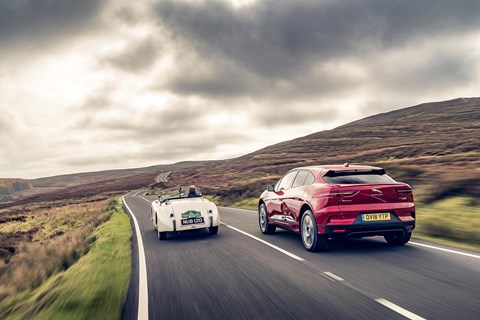
And the i-Pace is the sports 4×4 of the future. It is not sold on its surfeit of speed (124mph top speed, more or less the same as the XK120) but, rather, its absence of emissions. Back in the ’40s and ’50s (and right through to the early Noughties) the only thing an electric motor was any good for, on cars, was cranking the petrol or diesel engine into life. Now, they are the future. And the i-Pace is the best-driving battery-electric car we’ve seen.
It’s low for an SUV too, as much big hot hatch in proportions as trad 4×4 (130mm lower than a Cayenne, 345mm lower than a Range Rover). Also trend-setting is its stance. Note the cab-forward style, almost like a mid-engined sports car. Indeed, Jaguar design director Ian Callum will tell you the lovely C-X75 Jaguar mid-engined concept inspired the looks. Callum will also tell you the i-Pace is as much sports car as SUV (this, coming from the man who styled the comely F-Type).
Read our full Jaguar i-Pace review
The cab-forward look is a big departure for Jaguar. Check the i-Pace alongside the XK120, which devotes fully half its length to shrouding its big, beautiful straight-six. All Jaguars were long of bonnet until the i-Pace. The change reflects the reality that electric cars do not need lengthy bonnets, despite what rival electric car styling may suggest. There is no big engine to devote a bay to. Rather, electric motors are small, and often (as in the i-Pace) mounted at floor level.
The cab-forward stance means more of the car’s length can be devoted to passenger space. The i-Pace is the best-packaged EV on the market, and by some margin. Back-seat space and boot room are voluminous. Here is a car with a smaller footprint than a Macan but more room than a Cayenne. It is the first electric car that throws off the shackles of old-school petrol-car design thinking. It’s a new-generation Jaguar that previews the inherent advantages of a new generation of powertrain.
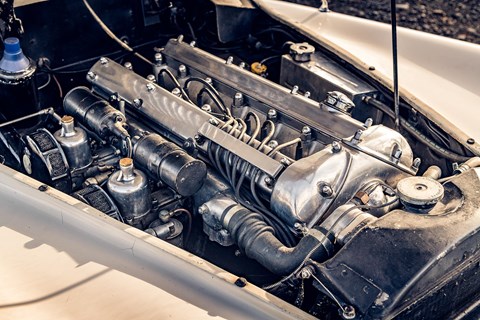
It is a car built around its powerplant, just as the XK120, precisely 70 years older than the i-Pace, showcases its engine.
On the old roadster, we see a magnificent big-chested straight-six of 3.4 litres. The XK120 saw the debut of the famed XK power unit that would go on to power Jaguars of distinction, including the best E-Types and the finest XJ saloons, for the next 40 years. The XK120 is a striking car built around a stunning engine. Its name reflects its power unit and its top speed, the XK120’s twin hallmarks.
So, on an unseasonably sunny autumn day we gather Jaguar’s past and future, in and around the Snowdonia National Park. The roads are as stunning as the scenery: fast, undulating, deserted, winding, and among the favourite driving routes of Jaguar’s chief chassis engineer Mike Cross. The i-Pace was partly born here. XK120s have been exercised here for seven decades, ever since eager young men in flat caps and tweeds first experienced the liberating joy of a powerful sports car.
Further electric car reading
Like the i-Pace – which started as a concept – the XK120 began life as a show study. Its role at the 1948 London Motor Show was to promote Jaguar founder William Lyons’ new engine that would soon see service in bigger-volume saloons. It was an advanced long-stroke unit, massively undersquare (83mm bore x 106mm stroke). Little wonder it had such plentiful low-speed torque.
It was easy to drive fast, a significant factor in its subsequent and distinguished motorsport successes (not least five Le Mans wins in the noses of C- and D-Types). Underneath handsome polished alloy covers were a pair of chain-driven camshafts driving atypically large valves in hemispherical combustion chambers (unusual and advanced for their day). There was a light aluminium alloy head, atop a big meaty cast-iron block. XKs were renowned for their toughness, as well as their torque. Twin sidedraft SU carburettors fed fuel to the big-chested motor.
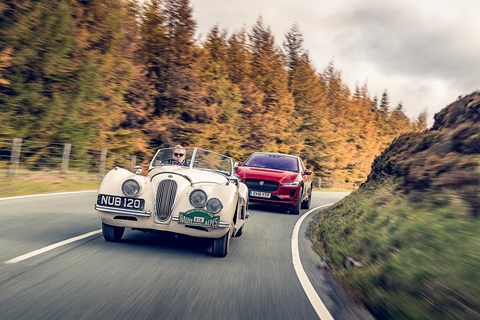
Reaction from war-ravaged Britain was predictably ecstatic to such a beacon of modernity, style and hope. The XK120 was the road-going equivalent of the equally futuristic and stylish De Havilland Comet. The world’s first commercial jet airliner first flew in 1949, the same year the XK120 would verify its claimed top speed and justify its badge during a speed run on Belgium’s Ostend-Jabbeke motorway (in fact, a prototype did more than 130mph). It would remain the fastest production car in the world until the Mercedes 300SL of 1955.
Earl’s Court endorsement earned, Lyons commissioned a few hundred XK120s in aluminium bodies that were largely hand formed. Our test car, built in 1950, was one of those cars. NUB 120 is probably the most famous of all XK120s and very possibly now the most valuable. This is mostly because of its distinguished competition history in the hands of Ian Appleyard. NUB 120 tasted success in the RAC, Tulip and Alpine rallies, with Appleyard’s wife – Patricia, William Lyons’ daughter – acting as navigator. It is now owned by the Jaguar Heritage Trust. It is a car I personally know well. Just over a decade ago, my friend Steve Cropley (formerly of this parish) and I drove it in the Mille Miglia.
The lightweight aluminium body was fitted to a modified steel and ash wood frame, largely borrowed from the contemporary Mark V saloon that also debuted at the 1948 Earl’s Court show to rather less fanfare (it used Jaguar’s older pushrod straight-six).
By 1950, it was clear the XK120 was a sales success. To meet the strong demand, mostly from the US, Lyons commenced mass production using steel bodies (but still with aluminium doors, bonnet and boot). A fixed-head coupe version and a drophead coupe, using a fabric roof and wind-up windows, appeared later.

Entry to the snug cockpit is by a tiny lightweight aluminium door, opened by an internal pullcord. The seats, recently reupholstered in leather, are thickly padded and comfortable. You sit close to the tall upright four-spoke metal steering wheel, thin of spoke and slim of rim. The rim brushes the top of your thighs.
A Jaguar logo on the wheel hub stares at your chest and the steering column points at your heart. It can be telescopically adjusted, but it always feels far too close. Mind you, bent arms and heaving
shoulders are necessary to manoeuvre that big ship-sized wheel at low speed – naturally, there is no power assistance. Once on the move, the recirculating-ball steering is nicely weighted and decently precise though rack-and-pinion would come later with the XK140, the XK120’s chunkier and less celebrated successor.
Press the starter button and the XK120 motor barks into life and settles down to a throaty and uneven burble. This contrasts mightily with the i-Pace, which powers-up silently. Equally contrasting is the stench: in the XK120’s open cockpit you can smell the cocktail of old-car pollutants.
The clutch is stiff, and the Moss four-speed gearbox needs a firm hand. It’s the same (often criticised) gearbox used in early E-Types more than a decade later. The shift is precise but slow. The shifter itself is a little Bakelite-capped shaft, small and dainty, rising from a leather gaiter. It’s right next to your left thigh with the tall chromed fly-off handbrake lever beside the gear stalk.
Instruments are haphazardly sited on the leatherette-skinned metal dashboard. The tacho, whose dial spins anti-clockwise, is redlined at a high (for the era, and for a long-stroke engine) 5200rpm. On this rally version of the XK120, there are also old stopwatches in front of the passenger seat.
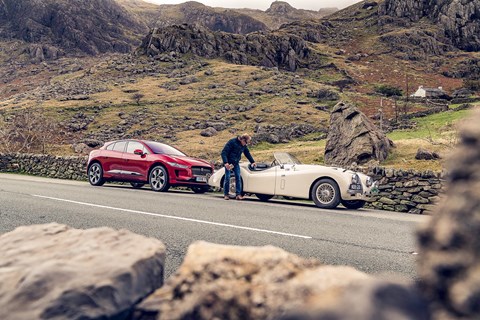
Move off and you’re immediately reminded just how feelsome an old roadster can be. The big steering wheel does a little jig in your hands as you traverse bumps. The tyres on their lovely wire wheels stride the tarmac, following the cambers closely, richly communicating the road surface below. It’s like a big cat stalking.
The engine growls and barps, your hair is being tugged hard by the wind – gushing over that chrome-rimmed split-screen – and your butt is being kicked by the rear wheels, suspended by leaf springs and a solid axle. You sit on plywood, part of the ash frame, trimmed in carpet. A wooden car frame! It was perfectly common back then, and of course old-school Morgans still use ash frames.
Oh, the exhilaration! Prod that throttle hard and the XK120 jumps with alacrity. You’re soon powering over the moorland roads, rather as Ian Appleyard must have done on the Alpine Rally, and the newly fitted Pirelli Cinturato tyres grip well and provide good feedback. It’s fast, this old car. It has 180bhp and weighs 1295kg (heavier than some rivals: blame the chunky frame). But of course, like all old roadsters, it feels much faster than it is. It’s a deeply sensory experience, the exact opposite of the hermetically sealed modern SUV. In the XK120 you’re riding a racehorse. Onboard the i-Pace you’re in a private jet cruising at 30,000 feet.
In the XK120, the valleys echo to the sound of petrol combustion. In the i-Pace, it is eerily silent, just the wind. In the XK120, you drive behind that big lovely long aluminum bonnet, louvres expelling heat and noise, and you can see that long nose rising and falling over the road crests, like a powerboat’s bow.
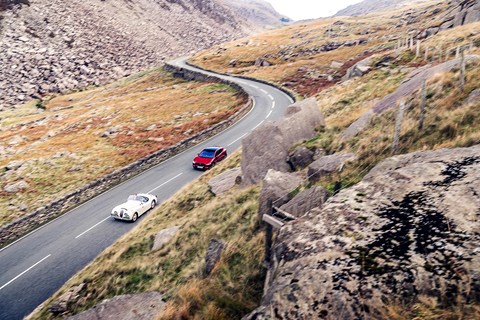
It’s a deeply involving car, and physical. Meaty steering, heavy clutch and brakes, firm ride. The brakes are terrible – the XK120’s biggest flaw. The drums had little chance of quelling the enthusiasm of such a fast sportster. Jaguar would soon after pioneer caliper-type discs on the racing C-Type, a car based on the XK120.
The engine is a gem. It can pull out of hairpins in a high gear, the six-pot digging deep. Gearshifting can be kept to a minimum. Can you imagine how such speed and power and drama must have felt 70 years ago, in rationed and benighted Britain? When most cars would struggle to exceed 60, and when cars were boxy and crude? Little wonder most XK120s went to America, where they dreamed bigger and where pockets were deeper.
It was the greatest sports car of its day, the most beautiful, the most graceful, and the fastest. It was the roadster rebel with a cause, and it put Jaguar (known as SS Cars before the war) on its path to sporting glory, subsequently consummated with Le Mans wins and then, finally, the pinnacle that was the E-Type.
The i-Pace is the next chapter in Jaguar’s sports car story. Ian Callum says it’s the most significant Jaguar since the E-Type. Gone is the styling timidity of most modern electric cars, which reassure the cautious with their familiar style and fail to utilise the inherent packaging advantages of this new powertrain.
Like some rivals, the i-Pace packages all its major mechanicals (including two electric motors and the lithium-ion batteries) in a skateboard-style platform. This gives greater design freedom for the bodywork above, notes Callum.
Revealed: the best electric cars and EVs
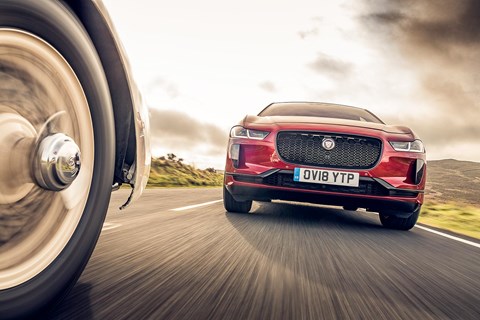
The styling and packaging impress. But the true genius of the i-Pace is the way it drives. Just as the XK120 did seven decades ago, so the i-Pace sets a new dynamic standard. Apart from their occasionally sensational standing-start acceleration, pure electric cars are mostly dynamic dullards. They are uninvolving electric appliances, dead of steering and dull in feedback. Some feel as though they’re driven by remote control: video-game cars. The i-Pace feels like a good analogue car, not a digital droid.
It is surprisingly brilliant on a racing circuit, previously experienced at the Autódromo Internacional do Algarve in Portugal. At speed, it comes alive: sharp, flat-cornering, tactile, throttle-responsive and fast. The power is precisely meted to each wheel, which helps handling precision. It’s more exact than the distribution offered by an engine and an electro-mechanical 4×4 system.
Just as impressive is the way it powers over the undulating and snaking blacktop of north Wales. It’s quiet and fuss-free. Yet it’s still involving and enjoyable. Body control is outstanding. It feels like a good sports car, never mind that SUV bulk and height. It’s like driving a Ferrari from the first floor. Of course throttle response is EV-instant, there is no gearchange, and no engine noise, save for a faint jet-like whirr. Just the slap of those big tyres, on their big 20-inch wheels, flush on the outside for better aero, and the distant whine of those regen brakes.
So it’s quiet, it’s comfortable, it’s easy to drive, it doesn’t pollute, and there’s plenty of space for five and all the sports equipment they’ll ever need. Welcome to the sports car of the future.
But, just occasionally, I’d want a reminder of another age. When cars were more animate, and growled and thrilled and serenaded, and when sports cars were small and light, and driving was a challenge and big speed was heroic. There would be no better way to celebrate such felicity than behind the wheel of the car that forged the post-war roadster, the Jaguar XK120.
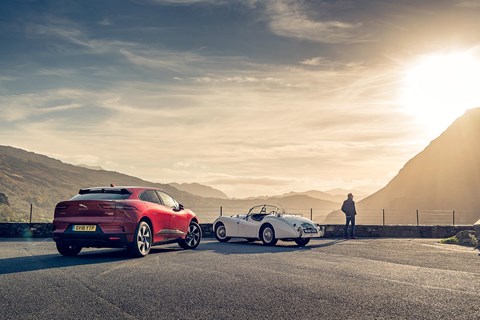
Jaguar i-Pace specs
Price £74,390
Engine Twin e-motors, 394bhp, 513lb ft
Transmission Single-speed gearbox, all-wheel drive
Performance 4.8sec 0-62mph, 124mph, n/a mpg, 0 g/km CO2
Suspension Double-wishbone front, multi-link rear, air springs
Weight 2133kg
Jaguar XK120 Roadster
Price £1759
Value now £100,000
Engine 3442cc straight-six, 180bhp @ 5100rpm, 195lb ft @ 2500rpm
Transmission 4-speed manual, rear-wheel drive
Performance 10.0sec 0-62mph, 125mph, 22mpg, n/a g/km CO2
Suspension Wishbone and torsion bar front, leafsprung live axle rear
Weight 1295kg
More comparison test reviews by CAR magazine